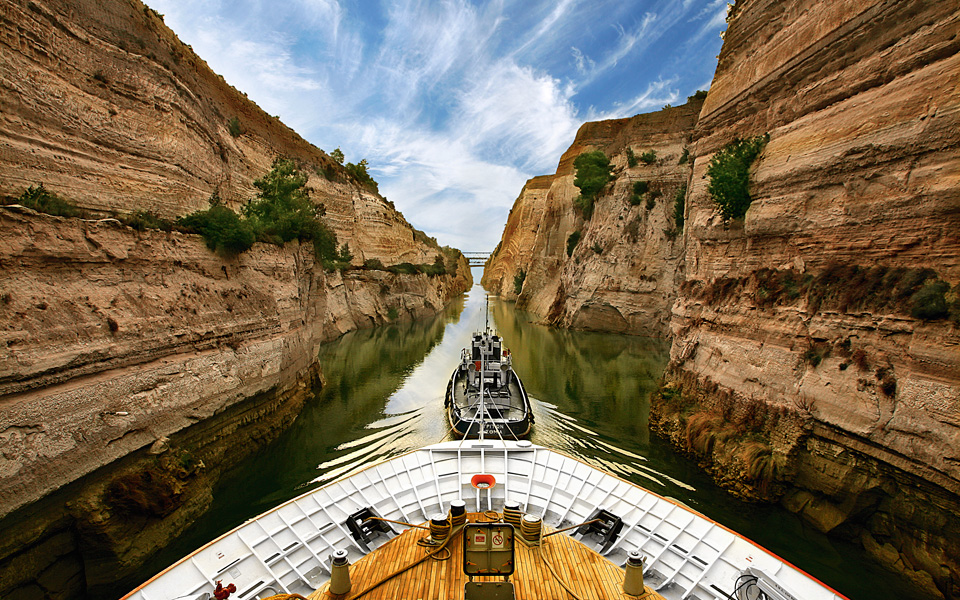Awe-inspiring to this very day, the Isthmus constitutes a feat of engineering and was pivotal in developing Greece’s maritime trade
When thrill-seekers of the modern day stare down the cliffs of the Corinth Canal, they are likely gripped by the same intrepid desire to conquer nature that compelled the Roman emperor Nero to hack away at solid rock with a pickaxe in AD 67. Awe-inspiring to this very day, the canal, or isthmus, constitutes a feat of engineering and was pivotal in developing Greece’s maritime trade.
The canal – a 6,343-meter-long gorge joining the Gulf of Corinth on the Ionian Sea side and the Saronic Gulf on the Aegean side – was inaugurated on July 25, 1893, as one of the crowning achievements of a state solidly on the path of westernization. That path, however, was anything but smooth and the story of the canal exemplifies the challenges of a country in turmoil, cash-strapped and dependent on foreign benefactors for its advancement.
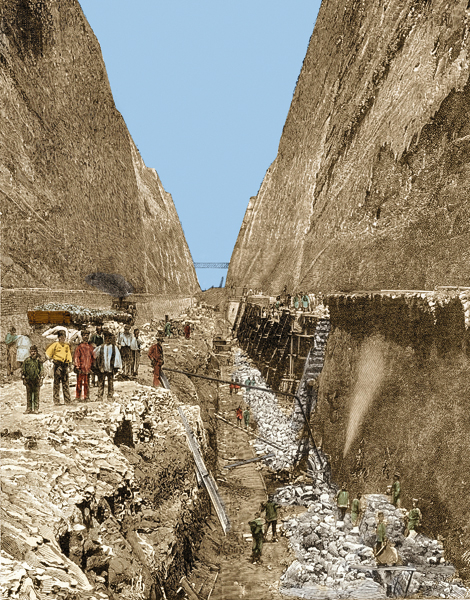
Construction of the Corinth Canal was completed in 1893.
© Corbis/ Smart Magna
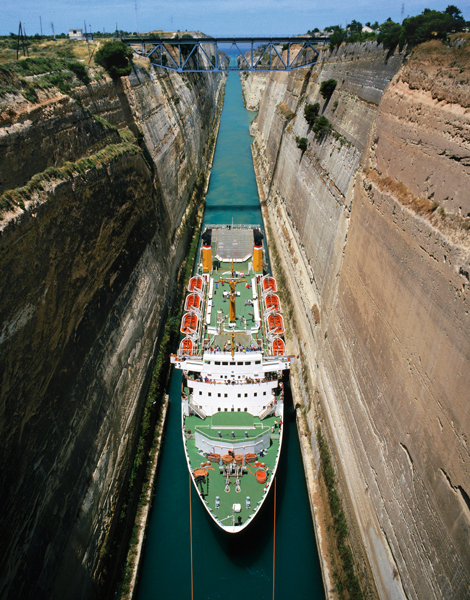
The canal is a 6,343-meter-long gorge joining the Gulf of Corinth on the Ionian Sea side and the Saronic Gulf on the Aegean side.
© Corbis/Smart Magna
As Nero and before him the 7th century BC tyrant of Corinth, Periander, knew only too well, one of the keys to boosting Greece’s agricultural exports and maritime trade was reducing the distance goods had to travel, and smashing through the isthmus – the swathe of rock that kept the ancient land of Pelops attached to the mainland – was the way to achieve this. But it was not until 1830 that the project was assigned by the first head of the newly independent Greek state, Ioannis Kapodistrias, to a French engineer who was one of many proponents of Saint-Simonianism, a “civilizing” movement targeting “underdeveloped” nations through industrialization.
Kapodistrias had ambitious plans for the country but little money to carry them out, so the idea was shelved until 1869, when the opening of the Suez Canal inspired Greek lawmakers to turn to a foreign consortium. The 99-year concession tender was picked up in 1881 by the Hungarian engineer István Türr, who had close relations with the developer of Suez, Ferdinand de Lesseps.
Türr secured funding from French banks and hired French engineers, who had worked on both the Suez and Panama canals. Chief engineer Vincent Dauzats drew the canal plan according to Nero’s original study and early excavations found boreholes dating to the Roman’s original attempt.
“ Kapodistrias had ambitious plans for the country but little money to carry them out, so the idea was shelved until 1869, when the opening of the Suez Canal inspired Greek lawmakers to turn to a foreign consortium. ”
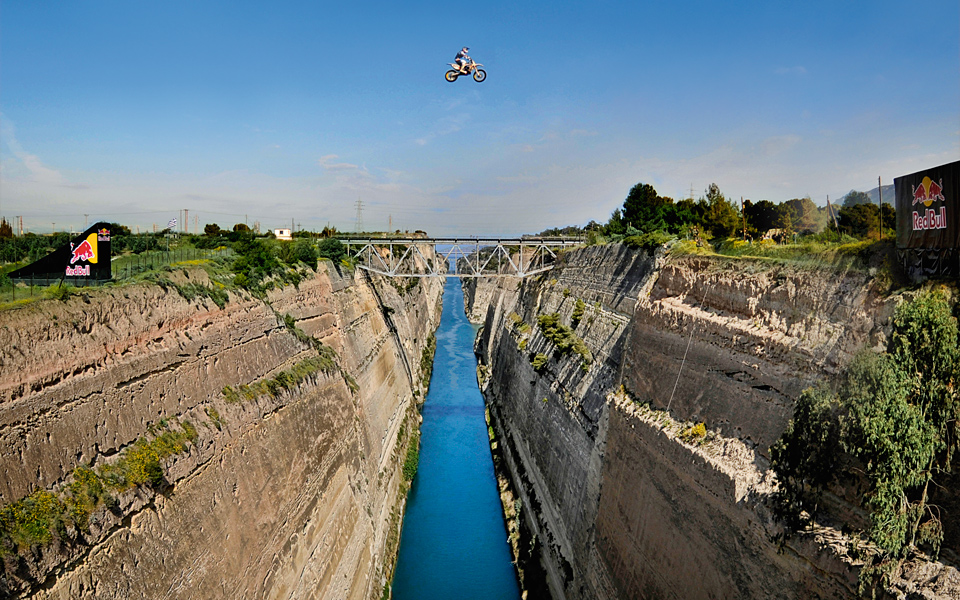
Australian motor-cross stuntman Robbie Maddison jumps over the 85-meter-wide Corinth Canal at a height of nearly 100 meters in 2010.
© Predrac Vluckovic/ Red Bull Photofiles
Buoyed by the success of Suez and believing themselves to be on a historic mission, Türr’s engineers were optimistic that this diminutive version of their grand achievement would present no difficulties. But they ran into unstable ground, making their technical plans untenable and pushing up the cost. After seven years the bankers pulled out and the project was abandoned. Another attempt by the Greek state was successful enough to ensure its completion in 1893. Just 13 years later, however, the new consortium went bankrupt, leading to the creation of a new management body, which operated the canal until 1980. Since then it has been in the hands of the Greek state.
Periander was wary of exacting the wrath of the gods and also lacked the technical capability to cut through the isthmus. Nero did manage to smash through 3,000 meters of rock on the Corinthian Gulf side but work was interrupted when he was called back to Rome to crush a rebellion. When the canal was eventually constructed in the 19th century, the state lacked the funds to broaden it, missing out on valuable revenue from its operation.
And today, at 8m deep, 24.6m wide at the top and 21.3m at the bottom, it cannot accommodate larger cruise ships and freighters, though ambitious plans to widen it are under way.
“ When the canal was eventually constructed in the 19th century, the state lacked the funds to broaden it, missing out on valuable revenue from its operation. ”
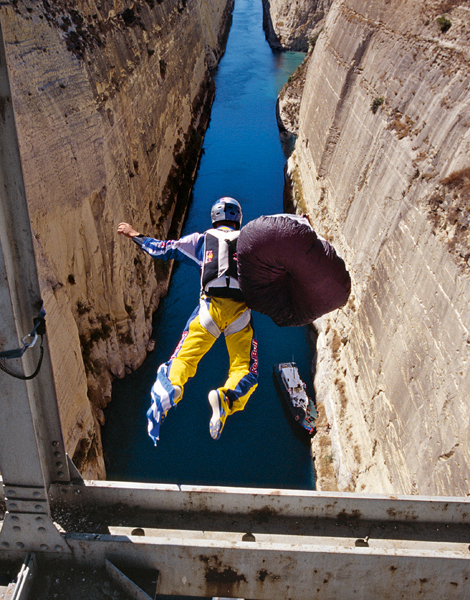
Austrian daredevil and BASE jumper Felix Baumgartner takes on the Corinth Canal in 2004. The 79m drop from the highest point is a challenge for thrill-seekers from around the world.
© Bernhard Spottel/ Red Bull Content Pool
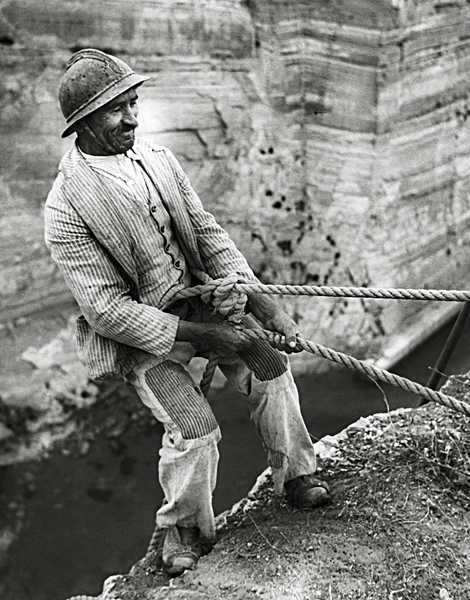
In this photograph from 1940, we see a worker at the Corinth Canal wearing a steel helmet to protect him from falling rocks.
© Corbis/Smart Magna
Nevertheless, the Corinth Canal remains a testament to the power of man’s vision. Perhaps it is the fact that it is small – and somehow more human – that continues to inspire feats of daring and awe. “It is one of the most exhilarating adventures I have undertaken. As you approach the canal you can see the massive cuts made on the side walls that rise so high above,” writes one seafarer on TripAdvisor. “It was one of the most memorable flights in my life,” daredevil Hungarian pilot Péter Besenyei, a veteran and founding member of the Red Bull Air Race, said after flying through the canal in March 2014.
And for bungee-jumping instructor Sotiris Pavlos of Zulu Bungee, plunging into the gorge is “like every first that you’ve built up to mythical proportions in your mind.”

